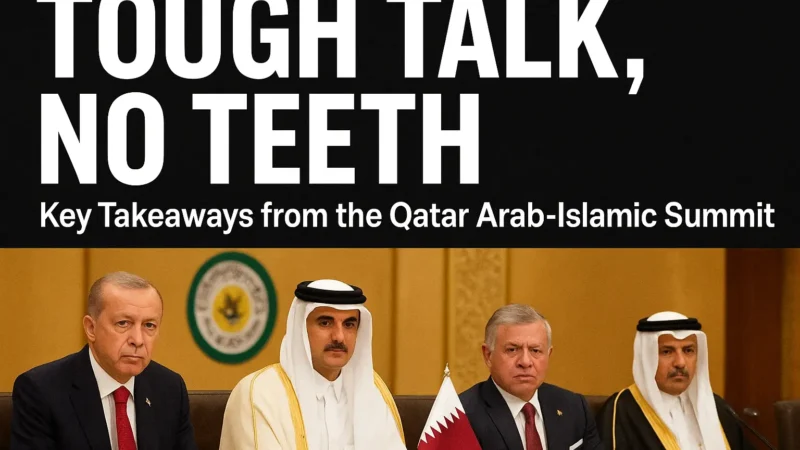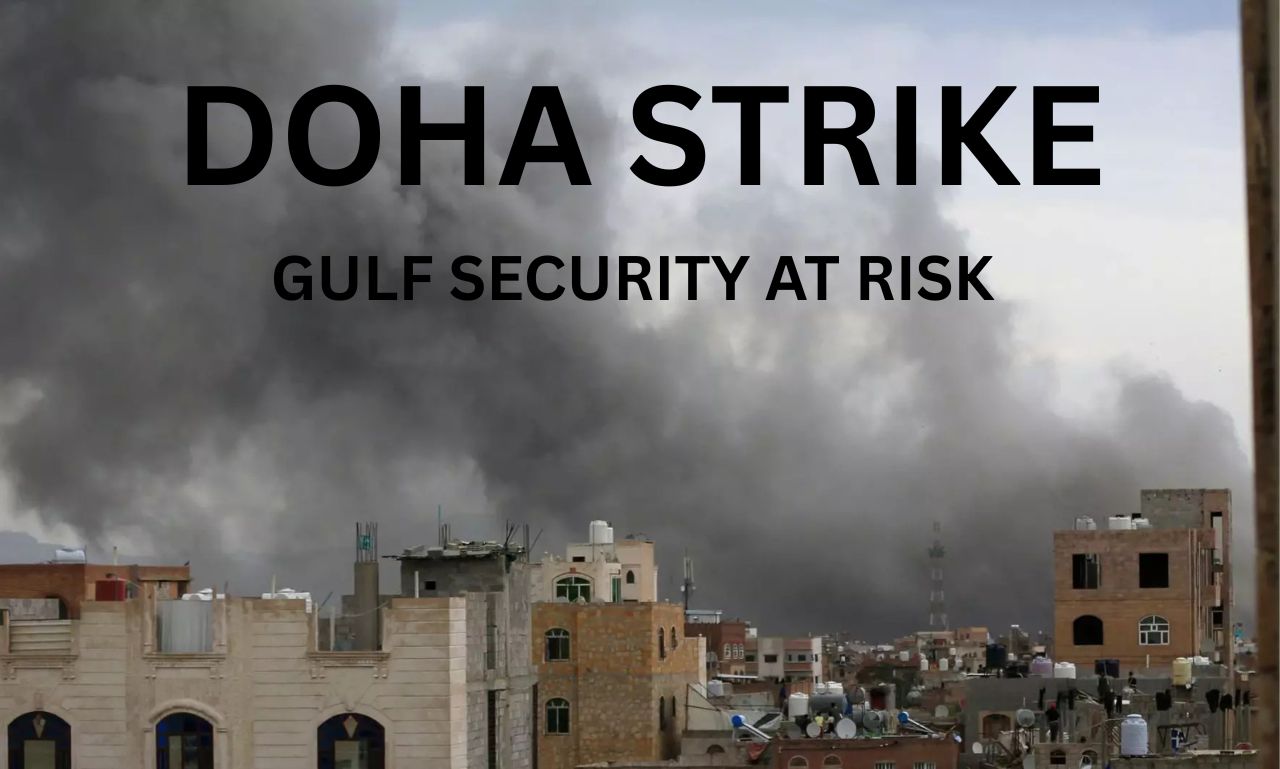The Paper Shield: An Analysis of the Israeli Airstrike in Doha and the Systemic Failure of Qatar’s Air Defence Network

(By Khalid Masood)
Introduction
On September 9, 2025, an Israeli airstrike shattered the peace in Doha, Qatar, targeting the senior leadership of Hamas. The most profound shock, however, was not the attack itself, but the deafening silence of Qatar’s multi-billion-dollar Integrated Air Defence System (IADS). This raises a critical question: why did Qatar fail to give any response to the Israeli attack when, just months earlier, Pakistani forces successfully shot down a number of Indian fighter jets at the outset of the brief May 2025 war that India called “Operation Sindoor“? This event serves as a critical case study into the vulnerabilities of modern, technologically advanced defences when confronted by a peer-level adversary employing a sophisticated, multi-domain offensive strategy. The central finding of this analysis is that the failure of Qatar’s defences was not attributable to a single cause but to a confluence of factors: Israel’s masterful execution of a long-range standoff strike, the likely application of advanced electronic and cyber warfare to neutralize Qatari sensors and command networks, and the inherent strategic dependencies embedded within Qatar’s foreign-procured military architecture. This report deconstructs the social media hypothesis of a “kill switch,” reframing it as a more nuanced concept of “dependency-as-a-vulnerability,” where reliance on a foreign power for critical software and data creates exploitable seams. The geopolitical fallout has been severe, undermining Qatar’s role as a regional mediator, straining its relationship with the United States, and setting a dangerous new precedent for military action in the Gulf. Ultimately, the Doha strike demonstrates that exorbitant spending on foreign military hardware is no guarantee of national security; true sovereignty in modern warfare requires not just possessing advanced systems, but the indigenous capability to integrate, operate, and defend them across the kinetic and electromagnetic spectrums.
Section 1: Anatomy of Operation “Summit of Fire”
The Israeli airstrike in Doha was a meticulously planned and executed operation that shattered regional norms and deliberately targeted an active diplomatic process. A reconstruction of the event reveals a calculated strategic decision by the Israeli government, one that prioritized a high-risk military objective over the preservation of a fragile, US-backed peace initiative.
1.1 The Strike: Timeline and Tactical Execution
On September 9, 2025, at approximately 3:46 p.m. local time (UTC+3), multiple explosions rocked the upscale Leqtaifiya residential district of Doha, an area known for housing foreign embassies and international schools. The attack was a complex aerial operation conducted jointly by the Israel Defence Forces (IDF), specifically the Israeli Air Force (IAF), and the Shin Bet intelligence service. Codenamed “Atzeret HaDin” (Day of Judgment) or “Operation Summit of Fire,” the mission involved as many as 15 IAF fighter jets that launched approximately 10 precision munitions at a residential compound on Wadi Rawdan Street.
The strike’s execution was characterized by remarkable precision. Satellite imagery and eyewitness accounts confirmed that the targeted compound, which served as a headquarters for the Hamas Political Bureau, sustained heavy damage, while adjacent structures, including a nearby gas station, remained largely unscathed. This surgical accuracy points unequivocally to the use of advanced precision-guided munitions (PGMs) designed to minimize collateral damage while maximizing effect on the intended target.
1.2 The Target: Hamas Leadership at a Critical Juncture
The explicit targets of the operation were the senior political echelons of Hamas, a roster that included key negotiators Khalil al-Hayya and Zaher Jabarin, alongside former leader Khaled Mashal and Shura Council head Muhammad Ismail Darwish. These individuals constituted the most senior figures of the organization’s external leadership, particularly after a nearly two-year Israeli military campaign had systematically eliminated much of its command structure within Gaza.
The context of the meeting is of fundamental importance. The strike was not random but was timed to coincide with the precise moment the Hamas leadership was convened to discuss and formulate a response to a new ceasefire and hostage release proposal brokered by the United States’ Trump administration. This timing transforms the operation from a simple targeted killing into a direct and deliberate disruption of an active diplomatic process.
Ultimately, the strike failed in its primary objective of decapitating the Hamas leadership. The organization quickly confirmed that its senior leaders had survived the attack. However, six fatalities were reported: Humam al-Hayya, the son of negotiator Khalil al-Hayya; Jihad Labad Abu Bilal, al-Hayya’s office director; three bodyguards; and Corporal Bader Saad Mohammed Al-Humaidi Al-Dosari, a member of Qatar’s Internal Security Force (Lekhwiya). Initial optimism among Israeli officials regarding the strike’s success quickly dissipated as reports of the leadership’s survival emerged.
The timing of the strike was not coincidental but deeply strategic. By attacking the negotiators as they were actively considering a peace proposal, the Israeli government signaled a clear preference for a military solution over a diplomatic one. This act effectively sabotaged the very process its key ally, the United States, was championing. The attack on the individuals in the room was simultaneously an attack on the negotiation itself, revealing a profound strategic divergence between the Netanyahu government’s goal of total military victory and the Trump administration’s objective of a negotiated end to the conflict.
1.3 Israeli Justification and International Condemnation
The Israeli government was swift to claim responsibility. Prime Minister Benjamin Netanyahu and Defence Minister Israel Katz stated the strike was a direct response to the October 7, 2023, attacks and, more immediately, to a deadly shooting at Ramot Junction in Jerusalem that had occurred the previous day. Netanyahu’s office issued a statement asserting that it was a “wholly independent Israeli operation” and that “Israel takes full responsibility”.
The attack, being Israel’s first known military strike on Qatar and a member state of the Gulf Cooperation Council (GCC), drew immediate and widespread international condemnation. The Qatari government decried the act as “state terrorism” and a “flagrant violation of international law and sovereignty”. This sentiment was echoed by the United Nations Secretary-General, the European Union, and key regional powers, including Saudi Arabia and the United Arab Emirates. In a significant gesture of solidarity, the leader of the UAE visited Doha shortly after the attack.
This operation represents a new, more aggressive phase in Israeli regional policy. Previously, Israel had refrained from targeting Hamas in Qatar, likely respecting its status as a key U.S. ally and a crucial mediator. By striking a target in close proximity to embassies and the Al-Udeid Air Base—the forward headquarters of U.S. Central Command (CENTCOM)—Israel deliberately crossed multiple red lines. This action demonstrates a significant shift in Israel’s risk calculus, where the perceived threat from Hamas now justifies military operations previously considered too diplomatically and militarily hazardous. For other Gulf states, this act shatters the illusion of “safe zones” for diplomacy and forces a strategic re-evaluation of the risks associated with hosting adversarial groups, even when done for mediation purposes with tacit Western approval.
Section 2: Qatar’s Multi-Billion Dollar Fortress: An Inventory of a Modern IADS
The complete failure of Qatar’s defences on September 9 is made more stark by the sheer scale of its investment in a technologically advanced, multi-layered Integrated Air Defence System (IADS). Over the preceding decade, Qatar had spent tens of billions of dollars to procure some of the world’s most sophisticated air defence and air superiority assets from the United States and Europe, creating what was, on paper, a formidable fortress.
2.1 Ground-Based Air Defence (GBAD): A Layered, Multi-National Shield
Qatar’s GBAD network was designed with a multi-layered approach, combining systems with different ranges and capabilities to counter a wide spectrum of aerial threats.
- Patriot PAC-3 (USA): At the core of its long-range defence, Qatar possesses 11 Patriot PAC-3 fire units, acquired in a 2012 deal with an estimated value of $9.9 billion. This system is the backbone of its defence against tactical ballistic missiles, cruise missiles, and advanced aircraft. It employs “hit-to-kill” interceptors that destroy threats through direct kinetic impact, representing the pinnacle of this class of technology. Its powerful AN/MPQ-65 phased array radar is highly resistant to electronic countermeasures, though its sector-scan nature can create surveillance gaps if not properly networked.
- NASAMS-2 (Norway/USA): For medium-range threats, Qatar operates 40 launchers for the National Advanced Surface-to-Air Missile System. Procured in deals valued between $2.2 and $2.5 billion, NASAMS is a highly mobile system optimized for engaging lower-flying and maneuverable targets like cruise missiles and UAVs. Its key strength lies in its networked and distributed architecture, which allows its high-resolution Sentinel radars and launchers to be geographically dispersed, enhancing survivability and coverage.
- THAAD (USA): For upper-tier, exo-atmospheric threats, Qatar has also ordered the Terminal High Altitude Area Defence (THAAD) system in a deal valued at $6.5 billion. THAAD provides a crucial defence layer against medium-range ballistic missiles, positioned above the Patriot’s engagement envelope.
- Rapier (UK) & Roland (France/Germany): Complementing the modern systems are legacy short-range air defence (SHORAD) assets. Qatar operates 18 Rapier launchers and 9 Roland units. These systems were acquired in the 1980s and are designed for point defence against low-altitude threats like helicopters and attack aircraft, featuring very short reaction times.
2.2 Air Superiority Assets: The Qatar Emiri Air Force (QEAF)
The kinetic layer of Qatar’s IADS is provided by the Qatar Emiri Air Force, which fields one of the most advanced and diverse fighter fleets in the Middle East.
- F-15QA “Ababil” (USA): The QEAF has 37 of these potent strike fighters on order, a bespoke Qatari variant that is among the most advanced versions of the F-15 ever built. It is equipped with state-of-the-art avionics, an Active Electronically Scanned Array (AESA) radar, and a powerful electronic warfare suite.
- Dassault Rafale (France): A fleet of 36 French-made Rafale multirole fighters provides a highly capable platform for both air-to-air and air-to-ground missions. They are notably equipped with the Meteor Beyond-Visual-Range Air-to-Air Missile (BVRAAM), one of the most effective long-range air combat weapons in the world.
- Eurofighter Typhoon (Multinational): Qatar also operates 24 Eurofighter Typhoons, renowned for their agility and performance in air superiority roles, while also possessing robust precision strike capabilities.
2.3 The Price of Security: Corroborating the $19 Billion Figure
Aggregating the publicly available costs of Qatar’s major GBAD procurements validates the assertion that its investment was immense.
- Patriot System: ~$9.9 billion
- NASAMS System: ~$2.2 – $2.5 billion
- THAAD System: ~$6.5 billion
- Early Warning Radar: ~$1.1 billion
The sum of these major deals alone amounts to approximately $19.7 to $20.0 billion. This figure strongly corroborates the claim of an investment exceeding $19 billion for the ground-based network, even before factoring in the costs of the older Rapier and Roland systems, decades of maintenance, personnel training, and the separate multi-billion-dollar acquisitions for the QEAF’s fighter fleet. The total active U.S. Foreign Military Sales (FMS) portfolio with Qatar is valued at over $26 billion, encompassing a wider range of military hardware.
The very composition of this arsenal, while impressive on paper, hints at a deep-seated systemic vulnerability. Integrating disparate systems from American, Norwegian, British, and Franco-German defence industries into a single, cohesive, and instantly responsive network is a monumental technical challenge. While modern systems like Patriot and NASAMS are built on NATO interoperability standards, ensuring they can seamlessly share data and commands with legacy European systems and a tri-national fighter fleet is far from guaranteed. This diversity, intended as a strength to create layers of defence, may have inadvertently created “seams” in the IADS—gaps in data fusion and command pathways that a sophisticated adversary could exploit.
Furthermore, Qatar’s procurement strategy appears to be a physical manifestation of its geopolitical hedging, balancing its critical security relationship with the United States by making major purchases from key European powers as well. While this approach makes perfect sense as a tool of foreign policy to cement alliances, the Doha strike suggests it may be fundamentally incompatible with the technical requirements of a truly integrated and effective national defence. The event highlights a critical lesson for other wealthy nations: a “best-of-breed” procurement strategy can lead to a “worst-of-all-worlds” operational reality if the deep, sovereign technical expertise required for true system-of-systems integration is lacking. The failure was not just of military hardware, but of a defence acquisition philosophy that may have prioritized diplomatic balance over operational coherence.
Section 3: How the Shield Was Broken: A Multi-Factor Failure Analysis
The total and silent failure of Qatar’s multi-billion-dollar IADS cannot be attributed to a single cause. Rather, it was the result of a multi-domain offensive strategy that likely combined advanced kinetic capabilities with non-kinetic effects, exploiting the inherent vulnerabilities of a modern, networked, but dependent, defence architecture. The notion of the systems being disabled by a simple “push of a button” is a simplistic interpretation of a far more complex and troubling reality.
3.1 The Standoff Doctrine: Striking from Beyond the Horizon
A leading explanation for the initial penetration of Qatar’s defences is that the Israeli Air Force executed the strike using long-range standoff munitions, allowing the launch aircraft to remain far outside Qatari airspace. This tactic would have immediately rendered the shorter-range Rapier and Roland systems irrelevant and would have significantly challenged the detection capabilities of the longer-range systems. The attack originated from a distance of approximately 1,800 km, making a standoff launch profile highly probable.
This theory is strongly supported by the statement from Qatar’s Prime Minister, Sheikh Mohammed bin Abdulrahman Al Thani, who said the “Israeli enemy used weapons that were not detected by radar”. While a modern fighter jet has a significant radar cross-section, a smaller, faster-moving cruise missile or glide bomb presents a much more difficult detection challenge. Israel’s arsenal includes a variety of such weapons, including the Rampage air-to-surface missile and the SPICE (Smart, Precise Impact, Cost-Effective) family of guided bombs, which have ranges of 150-300 km and can be launched from F-15, F-16, and F-35 platforms. This would have allowed the IAF jets to release their payloads over international waters in the Persian Gulf or from the airspace of a permissive third country, never triggering a direct alert from Qatari territorial air surveillance.
3.2 The Ghost in the Machine: Electronic and Cyber Warfare Dominance
While standoff munitions explain the initial penetration, they do not account for the complete lack of response from the entire IADS. The fact that Patriot and NASAMS batteries—systems specifically designed to counter cruise missiles—remained silent, and that no QEAF fighters were scrambled, points strongly toward a successful non-kinetic attack. A sophisticated electronic warfare (EW) and/or cyber campaign is the most plausible explanation for this total paralysis. Such an attack could have blinded, jammed, or spoofed Qatari radar systems, severed command-and-control links, or fed false information into the network, preventing any coherent response.
Israel is a world leader in this domain. Its defence industry, particularly IAI’s ELTA Systems, produces some of the world’s most advanced SIGINT platforms, jamming pods, and integrated EW suites designed specifically to defeat modern air defences. Specialized IDF units are dedicated to cyber and electronic operations, and it is a central tenet of Israeli air doctrine to achieve dominance in the electromagnetic spectrum before and during kinetic strikes. It is therefore highly probable that Israel conducted a coordinated EW and cyber assault that effectively neutralized Qatar’s entire defensive architecture before the munitions made their final approach. The systems were not just bypassed; they were likely rendered deaf, dumb, and blind.
3.3 The “Kill Switch” Hypothesis: Dependency as a Weapon
The viral social media discussions about a “push of a button” deactivation touch upon a deeper, more systemic vulnerability in modern arms sales. While a literal, built-in “kill switch” is a myth unsupported by credible evidence, the underlying concept of remote neutralization through technological and logistical dependency is a tangible strategic reality.
Modern military systems like the Patriot and advanced fighter jets are not just hardware; they are complex, software-defined ecosystems. Their effectiveness is critically dependent on the supplier nation—in this case, primarily the United States—for essential software updates, security patches, and, most importantly, Mission Data Files (MDFs). MDFs are the system’s brain; they contain the vast library of threat signatures that allow the radar and sensors to identify an enemy aircraft or missile. Without constant, timely updates from the supplier, a system’s ability to recognize and engage new or evolving threats degrades rapidly, eventually rendering it obsolete.
This dependency creates a powerful, albeit subtle, lever of influence. The supplier nation could withhold updates or, more insidiously, use its intimate knowledge of the system’s code and network architecture to exploit vulnerabilities. Academic and technical analyses confirm that the risk of hidden backdoors or malicious hardware trojans being inserted into the complex global electronics supply chain is a major concern for defence agencies. Given the close intelligence partnership between the United States and Israel, it is plausible that Israel possessed deep knowledge of the electronic and cyber vulnerabilities of the U.S.-made systems forming the core of Qatar’s IADS. A targeted cyberattack exploiting these inherent dependencies could achieve the same outcome as a mythical “kill switch”: rendering a billion-dollar defence network inert. The “push of a button” is not a physical switch, but a line of exploit code.
3.4 Systemic and Political Paralysis
Finally, the failure was compounded by potential systemic and political factors. As noted, the challenge of integrating multi-national systems may have created exploitable seams in the network’s architecture. Furthermore, possessing advanced hardware is meaningless without highly trained crews maintaining a constant state of high alert; the silent response raises serious questions about the operational readiness of Qatari forces.
There may also have been a critical moment of political hesitation. With the massive U.S. presence at Al-Udeid Air Base, Qatari commanders would be extremely reluctant to engage an unidentified aerial threat without explicit coordination with CENTCOM, fearing a catastrophic friendly fire incident. The timeline of the U.S. warning is crucial here. Both U.S. and Qatari officials agree the warning came too late to be acted upon, with Qatar claiming it arrived 10 minutes
after the explosions were heard. This communications failure precluded any possibility of a coordinated or even a purely Qatari defensive response.
The Doha strike should thus be viewed as a potential watershed moment in modern warfare. It demonstrates that the battle for control of the electromagnetic spectrum and cyberspace can be decisive, neutralizing a kinetic defence before it can even be brought to bear. For defence planners globally, this event suggests that procurement strategies focused solely on acquiring advanced platforms are obsolete. The most expensive missile is worthless if the radar that guides it is blind and the network that commands it is compromised.
Section 4: Geopolitical Shockwaves and Strategic Repercussions
The tactical and technical success of the Israeli operation has generated profound and lasting strategic consequences, sending shockwaves through the geopolitical landscape of the Middle East. The strike has fundamentally damaged Qatar’s international standing, strained its most critical alliance, and established a dangerous new precedent for regional security.
4.1 The Mediator Under Attack: The End of Qatari Neutrality?
The most immediate casualty of the strike was Qatar’s carefully cultivated role as a trusted, neutral mediator in the region’s most intractable conflicts. By hosting Hamas’s political office, Qatar had positioned itself as an indispensable communication channel for Western powers and Israel. This role was not undertaken unilaterally; Qatar has maintained that it hosted Hamas since 2012 at the explicit request of the United States and facilitated financial aid to Gaza with Israel’s own approval, all to maintain a line of contact and exert some moderating influence.
The Israeli strike shatters the very foundation of this role: the guarantee of a safe haven for negotiation. By attacking negotiators on its soil, Qatar’s credibility as a secure venue for diplomacy has been irrevocably damaged. Qatari Prime Minister Al Thani’s declaration that the strike “killed any hope” for a hostage deal and that his country would “reassess everything” about its mediation role underscores the depth of the betrayal felt in Doha. No party will again feel safe negotiating in Qatar under the implicit threat of assassination.
4.2 A Crisis of Confidence for a Major Non-NATO Ally
The attack has precipitated a severe crisis of confidence in Qatar’s strategic partnership with the United States. As a designated Major Non-NATO Ally (MNNA) and the host of Al-Udeid Air Base, the largest and most critical U.S. military installation in the region, Qatar had every reason to believe its sovereignty was implicitly underwritten by a U.S. security guarantee. That an attack could be carried out by another key U.S. ally, with at least some degree of American foreknowledge, calls the very value of the MNNA status into question.
The conflicting timelines provided by Washington and Doha regarding the advance warning are particularly damaging. The U.S. administration’s claim that it provided a warning, but “unfortunately, too late to stop the attack,” is starkly contradicted by Qatar’s assertion that the notification came a full 10 minutes after the explosions were heard across its capital. This discrepancy fuels a corrosive perception across the Gulf: either the United States was impotent to restrain Israel, or it was complicit in the attack. Both interpretations severely undermine faith in the reliability of U.S. security commitments.
This incident exposes a fundamental and perhaps irreconcilable contradiction in U.S. Middle East policy: the simultaneous commitments to maintaining Israel’s Qualitative Military Edge (QME), arming Gulf partners with advanced weaponry as a bulwark against Iran, and empowering those same partners to act as neutral mediators. The Doha strike demonstrates that in a moment of crisis, Israel’s perceived security needs, enabled by its QME, will invariably take precedence over the other pillars of U.S. policy, leaving American-armed and American-allied mediators vulnerable.
4.3 Redrawing the Lines: A New Precedent for Gulf Security
The strike establishes a dangerous new precedent that national sovereignty in the Gulf is conditional, subject to violation by more powerful regional actors acting on their own national security imperatives. For other Gulf states, particularly the UAE and Saudi Arabia, the event is a stark warning. It proves that their own multi-billion-dollar investments in Western military hardware and their security partnerships with Washington may not shield them from the actions of other U.S. partners.
The long-term consequence will likely be an acceleration of efforts toward strategic autonomy across the region. The perceived unreliability of the U.S. security guarantee will compel regional states to reduce their dependence on Washington and diversify their security relationships, potentially strengthening ties with powers like China or Russia, and investing more heavily in indigenous defence capabilities. Paradoxically, while often beset by rivalries, the strike has prompted a show of GCC solidarity with Qatar, born of a shared sense of vulnerability. By failing to protect one key ally from an attack by another, the United States has demonstrated the limits of its influence. The strike intended to eliminate a few Hamas leaders may have inadvertently dealt a critical blow to the foundations of the U.S.-centric security architecture that has governed the region for decades.
Section 5: Conclusion and Recommendations: Redefining Sovereignty in the Age of Networked Warfare
The Israeli airstrike in Doha on September 9, 2025, represents a watershed moment in modern warfare and regional geopolitics. It was not merely a failure of expensive military hardware but a systemic collapse of a defence philosophy predicated on the flawed assumption that importing technology equates to acquiring security. The event vividly illustrated the supremacy of a multi-domain, non-kinetically enabled offensive strategy over a static, hardware-focused defensive posture.
The Illusion of Purchased Security
The central lesson from the silent radars and grounded jets in Qatar is that billions of dollars in defence spending can create a “paper shield”—a force that is formidable in brochures and on parade grounds but is easily circumvented by an adversary who has achieved dominance in the electromagnetic and cyber domains. The initial premise that Qatar’s massive investment proved to be a waste of money is, in the context of this specific event, validated. The expenditure was not matched by the sovereign capability to integrate, operate, and defend the systems under the complex, contested conditions of 21st-century warfare.
Redefining Sovereignty
This incident forces a redefinition of national sovereignty itself. In the modern era, sovereignty is not merely defined by the integrity of physical borders but by “spectrum sovereignty” and “digital sovereignty.” The ability to control one’s own sensor networks, secure one’s own command-and-control data, and operate critical defence systems independently of a foreign supplier’s software and data pipelines is the new, non-negotiable benchmark of military and national power. Qatar possessed the former but critically lacked the latter, and this vulnerability was decisively exploited.
Strategic Recommendations
The Doha strike offers critical, if costly, lessons for small, wealthy nations reliant on foreign military technology, as well as for the Western powers that supply it.
For Qatar and other Gulf States:
- Invest in Sovereign Capabilities: The highest priority for future defence investment must shift from acquiring more foreign “platforms” (jets, missile batteries) to developing indigenous or jointly-controlled capabilities in electronic warfare, cyber defence, secure communications, and command-and-control integration. These non-kinetic capabilities are the true guarantors of a modern defence.
- Demand Data and Digital Sovereignty: In all future arms procurement contracts, nations must mandate full sovereign control over mission data files, access to essential source codes for system integration, and independent maintenance protocols. The era of accepting “black box” systems with critical foreign dependencies must end.
- Diversify Strategic Partnerships: While maintaining the crucial security relationship with the United States, regional states must actively pursue a multi-polar security strategy. Reducing dependency on a single security guarantor is now a strategic imperative for mitigating the risk of being caught in the crossfire of allies’ conflicting interests.
- Enhance Regional Defence Integration: The strike exposed a shared vulnerability across the GCC. Overcoming intra-GCC political rivalries to build a truly integrated, shared regional early warning and air defence network is the only credible long-term defence against sophisticated, coordinated external threats.
For Western Arms Exporters and Security Guarantors (e.g., the United States):
- Re-evaluate the Partnership Model: The current FMS model, which often prioritizes the sale of hardware while retaining critical technological control, creates brittle allies and ultimately undermines long-term influence. A new model focused on building genuine, resilient partner capacity is needed.
- Address the Dependency Dilemma: The perception of “kill switches” and software dependency, whether technically precise or not, is corrosive to trust and the health of alliances. Future defence agreements must include greater transparency, technology transfer, and collaborative development to build true partnerships rather than client relationships.
- Enforce Red Lines and Manage Alliances: The failure to restrain Israel from attacking another key ally inflicts significant damage on U.S. credibility as a reliable regional arbiter. Washington must demonstrate that there are tangible consequences for allies who take unilateral actions that directly contravene core U.S. diplomatic and security interests, otherwise its entire network of alliances is weakened.
Conclusion
The September 9th airstrike in Doha serves as a stark lesson in modern warfare, demonstrating that a multi-billion-dollar arsenal of advanced foreign hardware can be rendered useless against a sophisticated, multi-domain attack. The event shattered the illusion that security can be simply purchased, highlighting instead that true national defence in the 21st century is defined not by the quantity of advanced systems, but by the sovereign capability to integrate, operate, and defend them across the kinetic, cyber, and electromagnetic spectrums. The geopolitical fallout—a crippled mediation process, a strained alliance with the United States, and a new era of regional vulnerability—underscores the profound consequences of this paradigm shift. Ultimately, the silent defences in Doha signal a new, non-negotiable reality: without digital and spectrum sovereignty, a nation’s shield is merely paper-thin, and its security rests on the goodwill of others.
- About the Author






